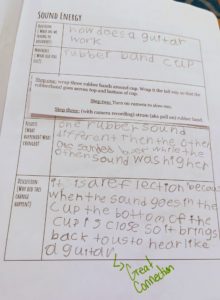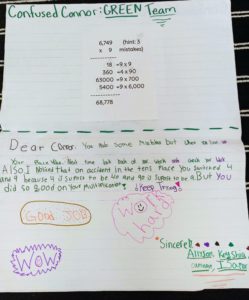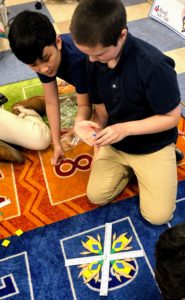Students will be respectful and active participants in their learning community.
On the first day of school this year it was clear that overall our learning community was going to be more likely to keep their thoughts to themselves rather than share. The reason for this reluctance varied in degree and source, some students simply needed to be invited, while other students needed to be warned and encouraged. For some students they were reluctant to share their thoughts out of fear, while others simply did not value their own thoughts. Upon realizing this we worked on supporting those students be either inviting them into the class conversation, celebrating even their “small” thoughts, or allowing them to turn and talk with a partner before they were asked to share with the whole class. Utilizing all of these strategies to value student voice and build student confidence.
A large part of this learning goal is group collaboration. My students came into the classroom on day one as student who overall work well in groups, every day this year there was at least on lesson which requires the students to at least work in partners if not in small groups. Through all this practice and discussion of what a good group member does and is the students went from ignoring a member who wasn’t participating or working collaboratively to inviting that person in or using conflict solving strategies to resolve the issue. Examples of this collaboration can be seen below.

This lab report comes from a student who can struggle with work production was supported and encouraged by his lab partners.
Students will think as readers, writers, mathematicians, scientists, and historians.
The structure of our classroom schedule this year allowed the students to be readers, writers, and mathematicians each day. When beginning these lessons we would discuss how we were going to be (ex. mathematicians) that day and then discuss the objective for the lesson. This would orient the students as to what “thinking cap” the students were being asked to put on for that lesson. My favorite lessons were when we could ask the students to wear multiple hats at once because of a cross content lesson. The classroom scheduled allowed for science and social studies three to five times per week for about half an hour, swapping between social studies and science units as we went. Of course, students would also put on these special “hats” at the start of each lesson also.
This learning goal and the following learning goal can seem similar because they both are looking for the students to improve as students. This learning goal is special from the next one because the children need to develop the ability to explain their thoughts and line of thinking across subject areas. In Room 312 this act of explaining ones thinking was a must! By the mid point in the year the students knew that no matter what the student was answering it was an expectation that the student follows up their answer with an explanation.
Reading:
During reading this year we saw wonderful growth in level. On the first day of school we had two students reading below grade level, nine students reading on grade level, and 11 students reading above grade level. By the end of April all of our students were reading above grade level ( except for our EPL one)! During the year the average student grew four to five reading levels on the Fountas and Pinnell leveling system, On students began the year below grade level, grew seven levels and will end the year above grade level.
Writing:
At the start of the year students were struggling and feeling frustrating while working to write a piece which was more complex than a simple three paragraph essay. Through practice with a variety of graphic organizers, focused modeling, and peer or teacher editing support, I am proud to say that the students have made great improvement in their ability to produce quality fourth grade work.
Math:
During the course of the year students have engaged in 12 math units, starting with a refresher on place value to now working on their conceptualization of fraction to decimal conversion and geometry concepts. Throughout the year students work independently, in small groups, partners and a a whole class. The students were also given the opportunity to utilize hands on materials and interact with a variety of technology driven learning tools. This allowed students to practice at their own pace and for me to track how each student was progressing.
Science:
During this year the students became scientists by completing research and lab reports about a variety of energy sources.The students were also given the opportunity to conduct experiments to explore different scientific concepts. Students were introduced to concepts through media content, real world connections, read alouds, and textbooks.
Social Studies:
This year students were given the opportunity to become historians and geographers. The majority of our social studies time was spent exploring immigration and the geography of the United States of America. During these units students empathized with immigrants of the past and present, asked many questions, created maps, and became experts on a state of their choice in the form of creating an informational book. As with every subject in Room 312, students participated in such activities individually, in partners, and in groups.
Examples:
Writing:-writing piece from the start to the end off googgle classroom.
Math:

An example of a group working together to identify mistakes in another persons work and kindly giving them advice on how to make corrections.

An example of students using technology to practice in a way which allows me as the teacher to receive immediate feedback.
Science:
To see a video example of the experiment click here.

This is an example of the students lab report which they filled out during and after the experiment.
Social Studies:
Students will grow from where they are, as students and people.
As previously mentioned this learning goal is near and dear to my beliefs as to the responsibilities of a teacher. The previous learning goal focused heavily on the students ability to improve and express their academic thinking. This learning goal focuses on the students ability to grow as students , but also as people. Meaning the students ability to function as a member of their learning community. At fourth grade developmental level this meant giving the students specific instructions on how to work and play with one another, giving opportunities to practice these strategies, and holding students accountable for their emotion regulation.
Over the year I had the pleasure watching students naturally mature, but also had the opportunity to lead or mediate conversations with students who were having independent struggle or a group confrontation. In some cases this was as basic as pointing how a student was being not being kind, or silently signaling tot the student that they need to take a break. Part of supporting my students in their development as people, is helping my students to learn new non-academic skills. My favorite example of this development occurred during a field trip to a local ice rink. During this time students were given ice skates and basically directed on the ice with no direction. I was static when I was given the opportunity to also enter the ice to emotionally and often physically support my students in this type of growth. I found that learning times such as these were also beneficial in the classroom because I was able to say to a student who was struggling on an essay the following, “Allyson, remember when you struggled to ice skate at first, but then we worked together and you got it? This is the same thing!”
This learning goal speaks to the importance of knowing your students beyond their academics, as an entire person!

This lesson required sharing and emotional support from one student to another. Here you see two students discussing each others project and sharing materials.





